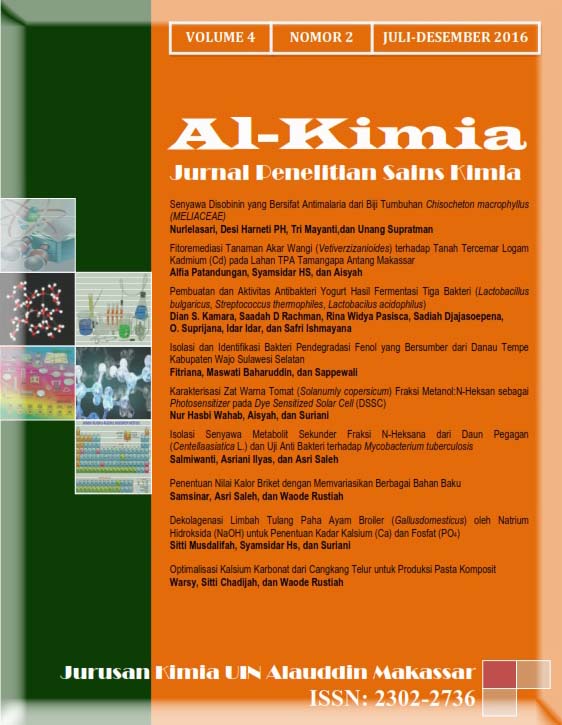Isolasi dan Identifikasi Bakteri Pendegradasi Fenol yang Bersumber Dari Danau Tempe Kabupaten Wajo Sulawesi Selatan
Abstract
Water pollution in Tempe Lake was consequence by people activity in around of Tempe Lake, such as domestic waste and agriculture waste. One of the dangerous pollutions which was resulted from the waste was phenol pollution. Phenol waste reduction efforts on Tempe Lake could be solved by biodegradation process using bacteria. This research aimed to: 1) Get the bacteria which was able to degrade phenol on samples sourced from Tempe Lake, Wajo South Sulawesi and 2) Identify the type of bacteria that can degrade phenol sourced from Lake Tempe, Wajo South Sulawesi. The Metods used in the research was making of media, isolation and purification of bacteria, identification of bacteria and testing the ability of phenol degradation. Bacterial identification tests include staining gram and biochemical tests (TSIA, SIM, MR-VP, urea, citric and sugar fermentation). The degradation test was performed using UV-Vis spectrophotometry with colorimetric method using follin reagent. The results showed that the bacterial identified as the genus Enterobacter spp and Klebsella spp which were gram negative bacteria. Test of phenol degradation at 48 hour incubation using UV-Vis shows that bacterial isolates C1F was able to degrade phenol 500 ppm to 3,091 ppm, bacterial isolate S1F was able to degrade phenol 500 ppm to 5,1153 ppm and bacterial isolate H2F was able to degrade phenol 500 ppm to 7,7834 ppm.
Downloads
References
Ulya, Amaliyatul, 2012, Pengaruh Variasi pH dan Suhu Terhadap Kemampuan Degradasi Fenol dan Pertumbuhan Bakteri Pendegradasi Fenol dari Limbah Cair Tekstil,Skripsi,Yogyakarta: Fakultas Sains dan Teknologi Universitas Negeri Sunan Kalijaga.
Akmal, 2010, Biodegradasi Fenol Limbah Cair Industri Tekstil Oleh Candida tropicalisI, Skripsi, Bogor: Fakultas Matematika dan Ilmu Pengetahuan Alam Institut Pertanian Bogor.
Dewilda, Yommi. 2010, Degradasi Senyawa Fenol Oleh Mikroorganisme Laut, Jurnal Teknik Lingkungan UNAND, 9(1): 59-73.
Juwita, Rahmy, 2014, Isolasi dan Karakterisasi Bakteri Pendegradasi Fenol dari Limbah Cair Rumah Sakit Umum Daerah (RSUD) Arifin Achmad Pekanbaru, JOM FMIPA, 1(2): 229-237.
Kementrian Lingkungan Hidup Republik Indonesia, Profil 15 Danau Prioritas Nasional, Kementrian Lingkungan Hidup, 2011.
Khafilzadeh, Farshid, 2010,Isolation and Identification of Phenol Degrading Bacteria from Lake Parishan and Their Growth Kinetic Assay, Africa Journal of Biotechnology, 9(40): 6723.
Lay, W., Bibiana, 1994, Analisis Mikroba di Laboratorium, Jakarta: PT Raja Grafindo Persada.
Milasari, Ika Nurita, dan Sukma Budi Ariyani, 2010, Pengolahan Limbah Cair Kadar COD dan Fenol Tinggi dengan Proses Anaerob dan Pengaruh Mikronutrient Cu: Kasus Limbah Industri Jamu Tradisional, Skripsi, Semarang: Fakultas Teknik Universitas Diponegoro.
Nurbaeti, Hajroh, 2014, Isolasi dan Identifikasi Bakteri Toleran Terhadap Fenol dari Limbah Cair Industri Batik Rumahan, Skripsi, Purwokerto: Fakultas Keguruan dan ilmu Pendidikan Universitas Muhammadiyah Purwokerto.
Nweke, C.O., Okpokwasili G.C., 2014, Kinetics of Growth and Phenol Degradation by Pseudomonas species Isolated from Petroleum Refinery Wastewater, Internation Journal of Bioscience, 4(7): 28-37.
Yuliastuti, Etik, 2011, Kajian Kualitas Air Sungai Ngringo Karanganyar dalam Upaya Pengendalian Pencemar Air,Thesis, Semarang: Program Pasca Sarjana Universitas Diponegoro.
Copyright (c) 2016 Al-Kimia

This work is licensed under a Creative Commons Attribution-NonCommercial-ShareAlike 4.0 International License.
Authors who publish with this journal agree to the following terms:
1) Authors retain copyright and grant the journal right of first publication with the work simultaneously licensed under a Creative Commons Attribution License that allows others to share the work with an acknowledgement of the work's authorship and initial publication in this journal.
2) Authors are able to enter into separate, additional contractual arrangements for the non-exclusive distribution of the journal's published version of the work (e.g., post it to an institutional repository or publish it in a book), with an acknowledgement of its initial publication in this journal.
3)Authors are permitted and encouraged to post their work online (e.g., in institutional repositories or on their website) prior to and during the submission process, as it can lead to productive exchanges, as well as earlier and greater citation of published work (See The Effect of Open Access).


